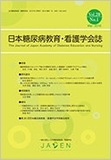Japanese
English
- 販売していません
- Abstract 文献概要
- 参考文献 Reference
本研究の目的は,2型糖尿病患者が家族サポートを肯定的に受け取り(感取),応答する(対応)力である家族サポート感取・対応力(ARRF)とHbA1c(NGSP)および関連要因との関係を,性別ごとに明らかにすることである.重度の合併症がなく,家族と同居している成人2型糖尿病患者を対象に,日本人2型糖尿病患者の家族サポート感取・対応力尺度,HbA1c,関連要因を調査項目とした自記式質問紙にて調査し,63名の有効回答を得た.
結果,ARRFとHbA1cとの関係において,男性ではARRFとHbA1cに有意な負の相関(rs=−.431)があり,女性では有意な正の相関(rs= .598)があった.また,ARRFと関連要因との関係では,男性においてARRFが有意に低かったのは,自覚症状がない,生活への支障がない,合併症がないと自覚している,大血管障害がない,親と同居している,就労しているという項目であった.女性においてARRFが有意に高かったのはBMI基準範囲内,インスリンなどの注射薬の使用があるという項目であった.
以上より,ARRFにおいて,性別により異なる支援方法が必要であることが示唆された.
The purpose of the present study is to investigate the relationship between the perceptiveness of and responsiveness to family support, which is the ability of patients with type 2 diabetes to positively recognize and respond to family support, and HbA1c, with a focus on relationship factors and gender differences. We conducted a self-administered questionnaire survey using a scale to measure type 2 diabetes patients' Ability to Recognize and Respond to Family support (ARRF), HbA1c, and relationship factors. The participants comprised adult patients with type 2 diabetes with no serious complications who lived with family. We obtained valid responses from 63 patients.
The results revealed that there were gender differences in the relationship between ARRF and HbA1c. ARRF had significant negative correlations with HbA1c in men (rs =-.431), but significant positive correlations with HbA1c in women (rs =.598). In addition, significantly low ARRF in men could be attributed to participant characteristics including awareness that having no subjective symptoms, issues that interfere with daily life, or macroangiopathy; awareness that one is free of complications; living with parent (s) and being in the workforce. Significantly high ARRF in women could be attributed to participant characteristics including being within the standard BMI range and the use of injected drugs, such as insulin.
Thus, it is suggested that different support methods are required depending on the gender of the patient.
Copyright © 2020, Japan Academy of Diabetes Education and Nursing. All rights reserved.


